Are you tired of struggling with stubborn stains and grease buildup on your roasting pan after cooking a delicious meal?
Fear not! In this comprehensive guide, we unveil the secrets to effortlessly clean your roasting pan to a sparkling shine, ensuring that every cooking experience ends with ease and satisfaction.
Say goodbye to endless scrubbing and hello to a gleaming roasting pan ready for your next culinary masterpiece. Let’s dive into the art of pristine pan maintenance and make cleaning a joyous part of your cooking routine!
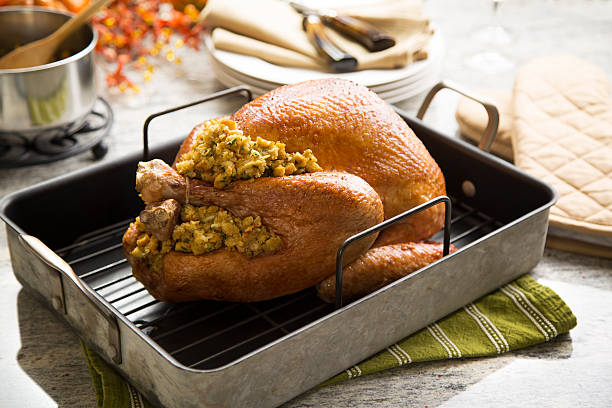
How To Clean Roasting Pan
Cleaning a roasting pan can be a daunting task, especially after cooking a delicious meal. However, with the right techniques and products, you can restore your roasting pan to its sparkling clean condition. Here’s a step-by-step guide on how to clean a roasting pan effectively:
Cool Down the Pan
After cooking, allow the roasting pan to cool down to a safe temperature before cleaning to avoid burns or damage to your cleaning tools.
Scrape Off Food Residue
Using a spatula or a non-abrasive scraper, gently remove any stuck-on food particles from the surface of the pan. Be careful not to scratch the pan if it has a non-stick coating.
Soak in Hot, Soapy Water
Fill the roasting pan with hot water and add a generous amount of dish soap. Let it soak for at least 30 minutes to loosen stubborn food residue.
Use Baking Soda Paste
For tough stains or burnt-on food, create a paste using baking soda and water. Apply the paste to the affected areas and let it sit for about an hour before scrubbing with a non-abrasive sponge or brush.
Vinegar and Baking Soda Solution
Another effective method is to sprinkle baking soda on the pan’s surface, followed by spraying vinegar over it. The foaming reaction helps lift stains and grease. After a few minutes, scrub the pan and rinse thoroughly.
Commercial Cleaners
If the above methods don’t fully clean the roasting pan, consider using a commercial oven cleaner or a specifically designed metal cleaner. Follow the manufacturer’s instructions carefully for the best results.
Use Lemon and Salt
Cut a lemon in half and dip the exposed side in salt. Use the lemon as a scrubber to remove stains and grease from the pan. The acidity of the lemon and the abrasiveness of the salt work together effectively.
Rinse Thoroughly
Once the pan is clean, rinse it thoroughly with hot water to remove any residue from cleaning products.
Dry Completely
After rinsing, dry the roasting pan thoroughly with a clean towel to prevent water spots or rusting.
Maintenance Tips
To keep your roasting pan in good condition, avoid using abrasive cleaners or metal utensils that can scratch the surface. Instead, opt for non-abrasive sponges or brushes and wooden or silicone utensils.
By following these steps and incorporating regular maintenance, you can keep your roasting pan clean and ready for your next culinary adventure.
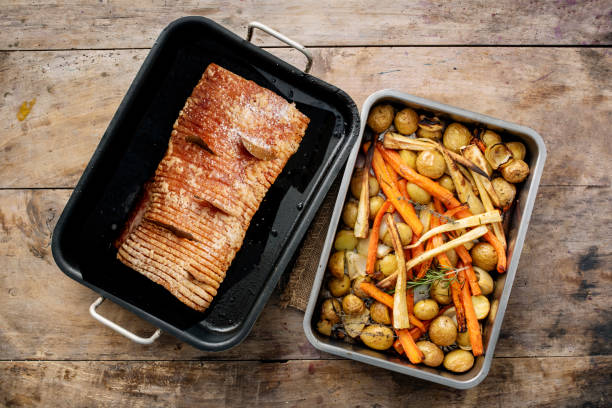
Understanding Roasting Pans
Understanding roasting pans is crucial for perfecting your culinary creations. These versatile kitchen tools are essential for roasting meats, vegetables, and more.
A high-quality roasting pan can elevate the flavor and texture of your dishes. When choosing a roasting pan, consider factors like material (stainless steel, non-stick, cast iron), size (small, large, extra-large), and features (rack, handles, depth).
Proper use and maintenance ensure longevity and optimal performance. Mastering the art of roasting with the right pan opens up a world of delicious possibilities in your cooking adventures.
Definition and common materials (e.g., stainless steel, non-stick coatings)
A roasting pan is a kitchen utensil specifically designed for roasting food in the oven. It typically features a rectangular or oval shape with low sides and may come with a roasting rack to elevate the food.
Roasting pans are commonly made from various materials, including stainless steel, aluminum, non-stick coatings, and enameled cast iron.
Each material offers unique benefits, such as stainless steel’s durability, non-stick coatings for easy cleaning, and cast iron’s excellent heat retention. Choosing the right material depends on your cooking preferences and needs, ensuring optimal results in your roasting endeavors.
Different sizes and shapes of roasting pans
Roasting pans come in a variety of sizes and shapes to accommodate different cooking needs.
Common sizes include small (ideal for roasting smaller cuts of meat or vegetables), medium (suitable for average-sized roasts), large (perfect for larger cuts like whole chickens or turkeys), and extra-large (for big gatherings or oversized roasts).
Shapes range from rectangular to oval, with some specialized pans designed for specific foods like fish or poultry. Choosing the right size and shape ensures even cooking and optimal use of oven space, enhancing the outcome of your roasting endeavors.
Typical uses of roasting pans in cooking
Roasting pans are versatile tools that find numerous uses in cooking:
- Roasting Meats: The primary purpose of a roasting pan is to roast meats like chicken, turkey, beef, pork, and lamb. The pan’s design allows for even heat distribution, resulting in tender, juicy, and flavorful meats.
- Roasting Vegetables: Roasting pans are also excellent for roasting vegetables such as potatoes, carrots, Brussels sprouts, and squash. The elevated rack helps to ensure even cooking and caramelization.
- Making Gravy: The drippings collected in the roasting pan can be used to make flavorful gravies and sauces, adding depth of flavor to your dishes.
- Cooking Large Portions: Roasting pans with ample size are perfect for cooking large portions of food, making them ideal for family gatherings, holidays, and special occasions.
- Baking: Some roasting pans can double as baking pans for dishes like casseroles, lasagnas, and baked desserts, offering versatility in the kitchen.
- Broiling: In addition to roasting, roasting pans with broiler-safe materials can be used for broiling meats and seafood, adding a crispy texture to the surface of the food.
- Collecting Drippings: The pan’s design with raised edges helps to collect drippings, preventing spills in the oven and making cleanup easier.
Overall, roasting pans are essential for achieving delicious, evenly cooked dishes with rich flavors, making them a valuable tool in any kitchen.
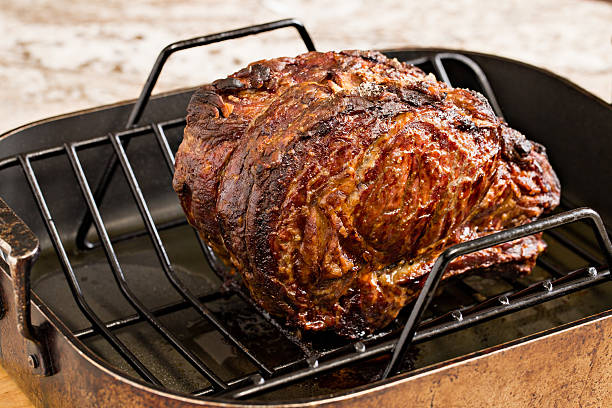
Why Cleaning Roasting Pans Is Important
Cleaning roasting pans is important for several reasons:
Preventing Food Residue Buildup
Proper cleaning removes leftover food particles and grease, preventing them from accumulating and becoming difficult to remove over time. This helps maintain the hygiene of the pan and prevents potential food safety issues.
Avoiding Cross-Contamination
Thorough cleaning of roasting pans prevents cross-contamination between different foods. Residual bacteria or flavors from previous cooking can transfer to new dishes if the pan is not cleaned properly, compromising the taste and safety of the food.
Maintaining the Quality and Appearance of the Pan
Regular cleaning helps preserve the quality and appearance of the roasting pan. Grease and food stains can tarnish the pan’s surface and affect its performance over time. Cleaning ensures that the pan remains in good condition for long-term use.
Overall, cleaning roasting pans not only enhances food safety but also prolongs the lifespan and functionality of the pan, ensuring optimal cooking results.
Tips and Techniques for Cleaning Roasting Pans
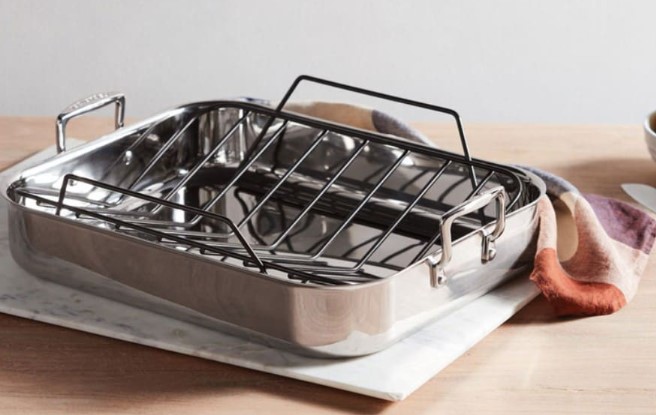
Cleaning roasting pans can be a breeze with the right tips and techniques:
Using natural cleaners like baking soda and vinegar
Using natural cleaners like baking soda and vinegar is an effective and eco-friendly way to clean roasting pans. Baking soda, with its mild abrasive properties, helps to scrub away tough stains and burnt-on food residues without damaging the pan’s surface.
When combined with vinegar, the fizzing reaction helps to lift and loosen stubborn grime, making it easier to clean. Moreover, baking soda and vinegar are non-toxic alternatives to harsh chemical cleaners, making them safe for use in the kitchen.
Simply sprinkle baking soda on the pan, add vinegar, and let it sit for a few minutes before scrubbing with a non-abrasive sponge or cloth. This natural cleaning method not only leaves your roasting pans sparkling clean but also reduces your environmental impact.
Soaking methods for easier cleaning
Soaking methods are incredibly effective for easier cleaning of roasting pans. By soaking the pan in warm water and dish soap immediately after use, you can loosen stubborn food residues and grease, making them easier to remove.
For particularly tough stains or burnt-on food, soaking the pan with a mixture of baking soda and vinegar can work wonders. The fizzing action helps to lift stains, while the soaking process softens hardened residues.
Another soaking method involves boiling water in the roasting pan on the stove and letting it cool before scrubbing. This hot water soak helps to loosen stuck-on food, making it easier to clean.
Overall, incorporating soaking methods into your cleaning routine can significantly reduce scrubbing time and ensure a thorough clean for your roasting pans.
Avoiding abrasive materials that can damage the pan
It’s crucial to avoid abrasive materials when cleaning roasting pans to prevent damage to the pan’s surface. Abrasive materials like steel wool, harsh scrub brushes, or abrasive cleaners can scratch and mar the finish of the pan, compromising its integrity and performance.
Instead, opt for non-abrasive cleaning tools such as soft sponges, microfiber cloths, or nylon scrub brushes. These gentle materials effectively remove food residues and stains without scratching or harming the pan.
Moreover, using mild cleaning agents like dish soap, baking soda, or vinegar ensures thorough cleaning without the need for abrasive techniques. By avoiding abrasive materials, you can preserve the quality and appearance of your roasting pans for long-lasting use.
Regular maintenance to prevent stubborn stains
Regular maintenance is key to preventing stubborn stains and keeping your roasting pans in top condition. After each use, promptly clean the pan with warm water and dish soap to remove any food residues or grease.
Avoid letting food sit in the pan for extended periods, as this can lead to hardened stains that are more difficult to remove.
If you notice any minor stains or residues, address them promptly with gentle cleaning methods like soaking in warm, soapy water or using a non-abrasive sponge. Regularly inspect the pan for any signs of buildup or discoloration, and address them before they become more challenging to clean.
Moreover, avoid using metal utensils or harsh abrasives that can scratch the pan’s surface and contribute to staining. Instead, opt for silicone or wooden utensils that are gentle on the pan.
By practicing regular maintenance and gentle cleaning techniques, you can prevent stubborn stains from forming and ensure that your roasting pans remain in excellent condition for years to come.
Special Considerations for Different Roasting Pan Materials
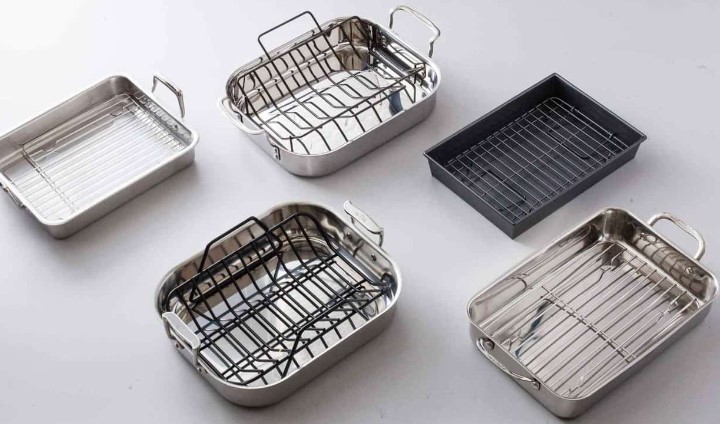
Different roasting pan materials require special considerations for cleaning and maintenance:
Stainless Steel
Stainless steel roasting pans are durable and resistant to corrosion. To clean stainless steel pans, avoid harsh abrasives that can scratch the surface. Instead, use a non-abrasive sponge or cloth with warm, soapy water.
For tough stains, soaking with baking soda and vinegar can be effective. To maintain the shine, dry the pan thoroughly after cleaning to prevent water spots.
Non-Stick Coatings
Non-stick roasting pans require gentle cleaning to preserve the coating. Avoid using metal utensils or abrasive cleaners that can scratch the non-stick surface.
Use a soft sponge or cloth with mild dish soap and avoid harsh scrubbing. After cleaning, rinse thoroughly and dry with a soft towel to prevent water spots.
Cast Iron
Cast iron roasting pans are excellent for heat retention and even cooking. To clean cast iron pans, avoid using soap as it can strip the seasoning. Instead, use a non-abrasive scrub brush or sponge with hot water to remove food residues.
Dry the pan thoroughly and apply a thin layer of oil to prevent rusting. Regular seasoning helps maintain the non-stick properties and prevents sticking.
Enameled Cast Iron
Enameled cast iron pans are coated with a protective enamel layer that makes them easier to clean than traditional cast iron. Use mild dish soap and warm water with a soft sponge or cloth for cleaning.
Avoid harsh abrasives or metal utensils that can damage the enamel coating. Dry the pan completely after cleaning to prevent chipping or discoloration.
By following these special considerations based on the roasting pan material, you can ensure proper cleaning and maintenance, prolonging the lifespan and performance of your pans.
Troubleshooting Common Cleaning Issues
Troubleshooting common cleaning issues with roasting pans can help you maintain their cleanliness and functionality:
- Stuck-on Food: If food is stuck-on, soak the pan in warm, soapy water for a few hours or overnight. Use a non-abrasive sponge or scrub brush to gently remove the residue. For stubborn stains, sprinkle baking soda over the area, add vinegar, and scrub gently.
- Burnt-on Residues: For burnt-on residues, fill the pan with water and add a few tablespoons of baking soda. Boil the solution on the stove for 10-15 minutes, then let it cool. The burnt-on residues should loosen, making them easier to scrub off.
- Grease Buildup: To tackle grease buildup, use a degreasing agent like dish soap or a mixture of vinegar and water. Scrub the pan thoroughly with a non-abrasive sponge to remove the grease. Alternatively, sprinkle baking soda on the greasy areas and scrub gently.
- Water Spots: To remove water spots, mix equal parts vinegar and water in a spray bottle. Spray the solution on the pan, let it sit for a few minutes, then wipe with a soft cloth. Rinse with water and dry thoroughly to prevent future spots.
- Rust Formation: If your pan develops rust, scrub the affected area with a mixture of baking soda and water using a non-abrasive sponge or brush. Rinse and dry the pan completely, then apply a thin layer of oil to prevent further rusting.
- Discoloration: Discoloration can occur due to heat exposure or burnt-on residues. Use a gentle abrasive like baking soda to scrub the discolored areas, then rinse thoroughly. For stubborn discoloration, create a paste of baking soda and water and let it sit on the affected areas before scrubbing.
By addressing these common cleaning issues promptly and using appropriate cleaning methods, you can keep your roasting pans clean, free from stains, and in excellent condition for cooking.
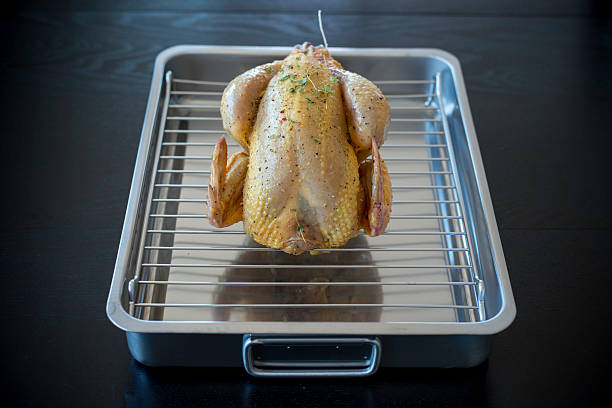
Frequently Asked Questions (FAQs) – How To Clean Roasting Pan
Q: What’s the best way to clean a roasting pan after a delicious meal?
A: The best way to clean a roasting pan is to start by soaking it in warm, soapy water. This helps loosen any baked-on food particles and makes scrubbing easier.
Q: Can I use baking soda and vinegar to clean my roasting pan?
A: Absolutely! Baking soda and vinegar make a powerful, non-toxic cleaning solution that can tackle stubborn stains and grease on your roasting pan without harsh chemicals.
Q: How do I remove burnt-on food from my roasting pan without damaging it?
A: To remove burnt-on food, sprinkle baking soda on the affected areas, then add a layer of vinegar. Let it fizz and sit for a few minutes before scrubbing with a non-abrasive sponge or brush.
Q: Is it safe to use steel wool or abrasive cleaners on my roasting pan?
A: While steel wool and abrasive cleaners can be effective, they may scratch the surface of your roasting pan. Opt for gentler cleaning methods to preserve its quality and appearance.
Q: What’s a natural way to eliminate odors from my roasting pan?
A: To banish odors, mix lemon juice with water and soak your roasting pan for a few hours. The citric acid helps neutralize smells, leaving your pan fresh and ready for the next use.
Q: Can I put my roasting pan in the dishwasher?
A: Most roasting pans are dishwasher safe, but always check the manufacturer’s instructions. Hand washing with mild detergent is often recommended for preserving the pan’s longevity.
Q: How do I prevent stains and discoloration on my roasting pan?
A: To prevent stains, avoid cooking acidic foods directly in your roasting pan for prolonged periods. Use parchment paper or a non-stick cooking spray for added protection.
Q: What’s a quick cleaning hack for my roasting pan after roasting meats?
A: After roasting meats, pour hot water into the pan and scrape off any drippings while the water is still hot. This helps prevent grease from hardening and makes cleaning a breeze.
Q: Can I use lemon and salt to clean my roasting pan naturally?
A: Yes, you can! Cut a lemon in half, sprinkle salt on the cut side, and use it as a scrubber for tough stains. The acidity of the lemon and abrasiveness of the salt work wonders.
Q: Any tips for maintaining the shine and luster of my roasting pan?
A: To keep your roasting pan looking like new, dry it thoroughly after washing to prevent water spots. A light coat of cooking oil or baking soda paste can also restore its shine.
Conclusion
In conclusion, cleaning a roasting pan doesn’t have to be a daunting task. By following these simple steps and using effective cleaning agents like baking soda and vinegar, you can restore your roasting pan to its sparkling best.
Remember to always let the pan cool down before cleaning, use non-abrasive tools to avoid scratching, and dry it thoroughly to prevent rust. With proper care and maintenance, your roasting pan will continue to serve you well for many delicious meals to come.
Other Articles You May Also Like: